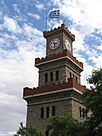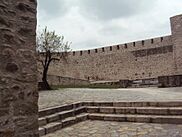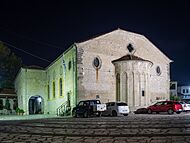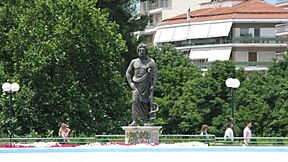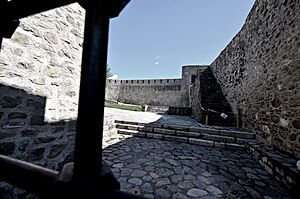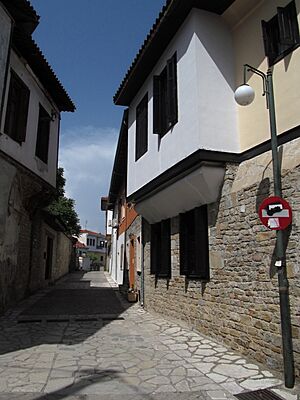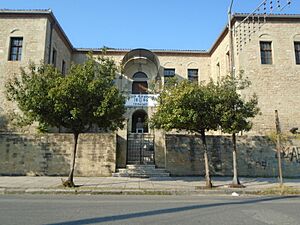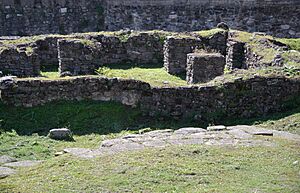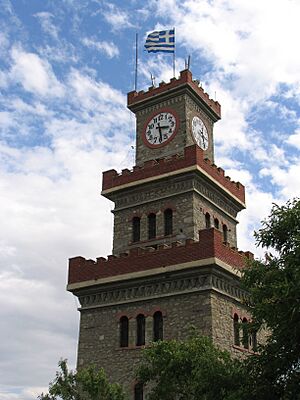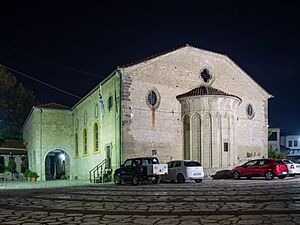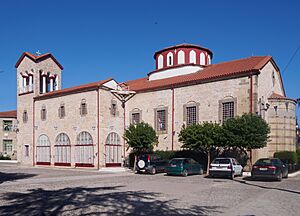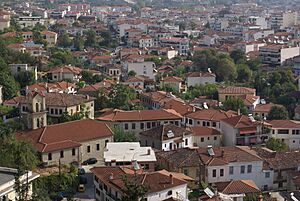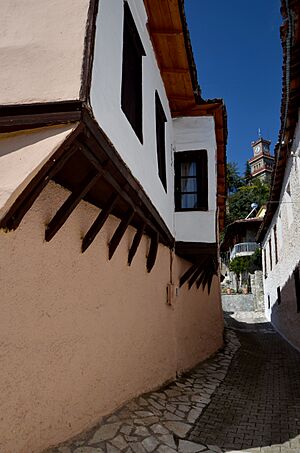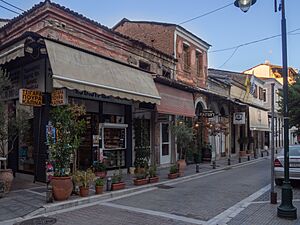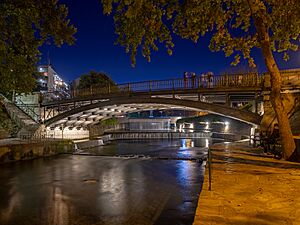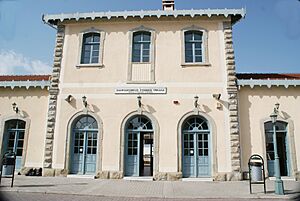Trikala facts for kids
Quick facts for kids
Trikala
Τρίκαλα
|
|
|---|---|
|
Clockwise from top: Central Bridge, Trikala Castle, a street in Varousi (old town), Osman Shah Mosque, Asclepius Statue, view of Varousi (old town), Panagia Faneromeni Church, Trikala Clock Tower
|
|
| Country | Greece |
| Administrative region | Thessaly |
| Regional unit | Trikala |
| Area | |
| • Municipality | 607.59 km2 (234.59 sq mi) |
| • Municipal unit | 69.2 km2 (26.7 sq mi) |
| Elevation | 115 m (377 ft) |
| Population
(2021)
|
|
| • Municipality | 78,605 |
| • Municipality density | 129.3718/km2 (335.071/sq mi) |
| • Municipal unit | 62,064 |
| • Municipal unit density | 896.9/km2 (2,322.9/sq mi) |
| Time zone | UTC+2 (EET) |
| • Summer (DST) | UTC+3 (EEST) |
| Postal code |
421 00
|
| Area code(s) | 24310 |
| Vehicle registration | ΤΚ |
| Website | www.trikalacity.gr |
Trikala (Greek: Τρίκαλα) is a city in northwestern Thessaly, Greece. It is the capital of the Trikala regional unit. The city is built along the Lithaios river, which flows into the Pineios river. In 2011, Trikala had about 81,355 people living there. The whole Trikala region had about 131,085 residents.
Trikala is a lively Greek city. It has beautiful old buildings and traditional neighborhoods. The city is close to the famous Meteora monasteries. It is also near the Pindus mountains. This area offers many cool places to visit. These include the Pyli stone bridge, Elati, Pertouli, and the Palaiokarya stone bridge with its waterfall. There is even a ski center in Pertouli.
Contents
- City's Name: Where Did Trikala Get Its Name?
- Trikala Through Time: A Journey Through History
- Must-See Sights in Trikala
- Fun Places to Visit Near Trikala
- City Services and Education
- Getting Around Trikala
- Trikala's Weather
- Sports Teams in Trikala
- Cities Trikala is Friends With (Twin Cities)
- Famous People from Trikala
- Images for kids
- See also
City's Name: Where Did Trikala Get Its Name?
The city's name comes from the ancient name Trikka or Trikke. This name was given after a nymph named Trikke. She was said to be the daughter of the river god Peneus or Asopos. The name Trikala first appeared during the Byzantine period. In Turkish, the city is known as Tırhala. In the Aromanian language, it is called Trikolj.
Trikala Through Time: A Journey Through History
Ancient Times: Birthplace of a Healing God
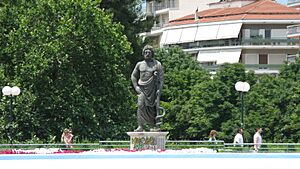
People have lived in the Trikala area since very old times. The oldest signs of people living here were found in the Theopetra cave. These date back to about 49,000 BC. Settlements from the Neolithic period (around 6,000 BC) have also been found.
The city of Trikala sits on the ancient city of Trikka or Trikke. This old city was founded about 3,000 years before Christ. It was named after the nymph Trikke. The ancient city was built in a good spot for defense. It was between a local hill and the Lithaios river. Trikka became an important place long ago. It was believed to be the birthplace of Asclepius, the god of healing.
The city had one of the most important and oldest healing temples for Asclepius. These temples were called asclepieia. Trikka is even mentioned in Homer's famous poem, the Iliad. It says Trikka sent thirty ships to the Trojan War. These ships were led by Asclepius' sons, Machaon and Podalirius. During the Mycenaean period, Trikka was the capital of a kingdom. Later, it became the main center of the Thessalian region called Estaiotis. This area is roughly where the modern Trikala Prefecture is today.
In later historical times, Trikke and its surroundings were very successful. The Achaemenid Persians took control in 480 BC. Ten years later, it joined the Thessalian money union. In 352 BC, it became part of Macedonia under Philip II. The city saw many tough battles between Macedonia and Rome. Even though Philip V of Macedon and his son Perseus tried to keep the city, it fell to the Roman Republic after 168 BC.
Middle Ages: Invasions and New Rulers
Even though the area was part of the Byzantine Empire, many groups invaded it. These included the Goths (396), Huns (447), Slavs (577), Bulgarians (986–1000), Normans (1082/3), and Catalans (1309–1311).
The name Trikala first appeared in the 11th century. It was mentioned in a book called the Strategikon of Kekaumenos. Later, in the early 12th century, it was in the Alexiad by Anna Komnene. A traveler named al-Idrisi described Trikala as an important farming center. He noted its many vineyards and gardens.
After the Byzantine Empire broke up in 1204, Trikala became part of the Despotate of Epirus. This rule lasted until 1259. Then, the Empire of Nicaea took the town easily after the Battle of Pelagonia. In the early 1300s, Trikala was the capital of a small, independent area. This area was ruled by Stephen Gabrielopoulos. After he died in 1332/3, the Epirote ruler John II Orsini took the city. But he was soon removed, and the Byzantine Empire took control again.
In 1348, Stephen Dushan conquered Thessaly. Trikala became part of his new Serbian Empire. A Serbian general named Preljub became the governor and lived in Trikala. In 1359, Dushan's half-brother Symeon Uroš made Trikala his home. He also founded the Meteora monasteries nearby in 1366/7. Later, local leaders ruled Trikala until the Ottoman Empire conquered Thessaly in 1393/4.
Ottoman Period: A New Look for the City
Under Ottoman rule, the city was known as Tırhala. In the early 1400s, a leader named Turahan Bey brought Muslim settlers to the city. He also gave special rights to the local Greek people. Turahan and his son built many buildings in the city. This made Trikala look like a typical Ottoman town. It had mosques, schools, baths, and inns. These buildings spread out beyond the castle and the Christian Varoussi area.
Trikala became the center of the local province. Many Muslim and Jewish people moved there. In 1454/5, the city had 2,453 people. By 1520/38, it had grown to 301 Muslim, 343 Christian, and 181 Jewish families. Trikala also became an important place for learning. The Trikke School taught famous thinkers like Dionysius the Philosopher. Christian children from Trikala sometimes became Janissaries, who were special soldiers.
In the 17th century, a traveler named Evliya Çelebi visited Trikala. He said the city had 2,300 houses. These were divided into sixteen Muslim and eight Christian neighborhoods. He also noted eight mosques, including the main Osman Shah Mosque. This mosque was designed by the famous architect Mimar Sinan. The city also had four public baths and many shops. Trikala was badly damaged by a big fire in 1749. It was burned again by Albanian soldiers during a local uprising. Despite this, its population stayed around 25,000 until the Greek Revolution in 1821.
Modern Period: Joining Greece and Becoming a Smart City
On August 23, 1881, Trikala became part of Greece. This happened with the Treaty of Constantinople. The city was briefly taken by Ottoman forces again in 1897. In the early 1900s, Trikala played a key role in helping farm workers. They protested against the big landowners in Thessaly. In 1906, Trikala became the city where Greece's first Agricultural Cooperative was founded.
Historically, Trikala had many Aromanians, a group of people from other regions. Much of the city's old Ottoman and medieval buildings were lost in the early 20th century. This was especially true after the city was rebuilt with a modern plan in the 1930s.
Today, Trikala is a lively Greek city. It is famous for the river that runs through its center. It is also known for its historical sites and charming old town.
Must-See Sights in Trikala
- The Asklepieion of Trikke archaeological site: This is one of the most important and oldest healing sites in Greece. It is believed to be where Asclepius, the god of medicine, was born. The site is next to St. Nicholas Cathedral and the old town.
- The Byzantine Castle: Emperor Justinian built this castle in the 6th century AD. It sits on the highest point of ancient Trikke. The Ottomans rebuilt it later. In the 17th century, they added a huge clock tower. A new clock tower was put up in 1936. Today, it is a symbol of the city and offers great views. The old town is located below the castle.
- The Old Town of Trikala: This area includes the Varousi and Manavika districts. Varousi was a Christian area during Ottoman rule. It is at the foot of the castle. Many old buildings from the 17th to 19th centuries are still there. The city's oldest churches, built between the 14th and 19th centuries, are also here. Manavika is another part of the old town. It has charming architecture and is known for its restaurants, coffee shops, and bars.
- The Greek Orthodox Churches of Trikala: Many historic churches are in the Varousi district. These include the Church of Virgin Mary Faneromeni (1853), Church of Virgin Mary Episkepsi (1867), and Saint Demetrius Church (1588).
- The Hill of Prophitis Ilias (Prophet Elijah): This is a wooded area with a lovely view of the city. It is close to the city center. The church of Prophet Elijah (built 1897) and the municipal zoo are on this hill.
- Lithaios river and the Central Bridge: The Lithaios river flows through the city center. The Central Bridge, built in 1886, connects the main square to the pedestrian street. The river banks are green and beautiful.
- The Mill of Matsopoulos: This old industrial building was built in 1884. Today, it is a museum and cultural center. During Christmas, it becomes the "Mill of Elves," a famous Christmas park.
- The Osman Shah Mosque: This mosque was built in the 16th century. It was designed by the famous architect Mimar Sinan. Behind the mosque is the tomb of Osman Shah.
- The Twin Ottoman bath (Hammam of Osman Shah): Also built in the 16th century, this bathhouse was likely designed by Mimar Sinan. It has been restored and is now a museum. It shows ancient pottery and other exhibits. The Tsitsanis Museum is on the upper floor.
- Other historic buildings: These include the Trikala Train Station (built 1886), the Courthouse, and the Folklore Museum.
Fun Places to Visit Near Trikala
Trikala is close to many interesting places for day trips. It is near the world-famous Meteora monasteries and Kalampaka. It is also close to the southern Pindus mountains. Here you can find the stone bridge of Pyli (16th century), the Byzantine Church of Porta Panagia, and the stone bridge and waterfall of Palaiokarya. Other popular spots are Elati, Pertouli, Neraidochori, and the Pertouli Ski Center.
City Services and Education
Trikala has the main hospital for the Trikala region. The University of Thessaly has a Physical Education and Sport Science department here. It opened in 1994. Trikala also has over 20 high schools. There is also a modern night technical school.
Trikala is known as the first "smart city" in Greece. This means it uses new technologies to help the city run better. It provides government services to people online, which is called e-governance. The city is also working to become Greece's first city ready for 5G technology.
Getting Around Trikala
The city is next to Motorway 3 (A3), also known as the E65 highway. KTEL is the main bus service in Greece. It has many buses connecting Trikala to nearby areas. You can also travel to Athens, Thessaloniki, and other cities by bus. Trikala also has a train station. There are daily train connections to Athens and Thessaloniki.
Trikala's Weather
Trikala has a Mediterranean climate (Csa). This means it has hot summers. The average high in August is about 34.5°C (94.1°F). Autumn and spring are mild. Freezing temperatures happen sometimes in winter nights. Snowfall is not usually heavy.
| Climate data for Trikala Castle | |||||||||||||
|---|---|---|---|---|---|---|---|---|---|---|---|---|---|
| Month | Jan | Feb | Mar | Apr | May | Jun | Jul | Aug | Sep | Oct | Nov | Dec | Year |
| Mean daily maximum °C (°F) | 10.7 (51.3) |
14.7 (58.5) |
17.3 (63.1) |
20.5 (68.9) |
26.7 (80.1) |
32.8 (91.0) |
33.5 (92.3) |
34.5 (94.1) |
30.6 (87.1) |
24.6 (76.3) |
17.1 (62.8) |
12.5 (54.5) |
23.0 (73.3) |
| Mean daily minimum °C (°F) | 1.8 (35.2) |
3.9 (39.0) |
5.7 (42.3) |
8.7 (47.7) |
13.4 (56.1) |
18.5 (65.3) |
20.3 (68.5) |
19.9 (67.8) |
17.3 (63.1) |
12.1 (53.8) |
8.9 (48.0) |
5.9 (42.6) |
11.4 (52.5) |
| Average precipitation mm (inches) | 58.6 (2.31) |
80.2 (3.16) |
76.4 (3.01) |
43.2 (1.70) |
41.8 (1.65) |
33.8 (1.33) |
17.0 (0.67) |
18.3 (0.72) |
55.7 (2.19) |
73.1 (2.88) |
75.6 (2.98) |
71.0 (2.80) |
644.7 (25.4) |
| Source: [1] 2010-2020 precipitation ,2019-2021 temperatures | |||||||||||||
Sports Teams in Trikala
- Trikala F.C. is a football (soccer) team. They played in Greece's top league as recently as the 1999–2000 season.
- Trikala 2000 B.C. was a basketball team. They played in Greece's top basketball league in 2008–09 and 2009–10. The team later stopped playing due to money problems.
- Aries Trikala B.C. is another basketball team. They played in Greece's top league for five seasons, from 2013–14 to 2017–18.
Cities Trikala is Friends With (Twin Cities)
Trikala has "twin city" relationships with several cities around the world:
 Amberg, Germany
Amberg, Germany Antiparos, Greece
Antiparos, Greece Banan (Chongqing), China
Banan (Chongqing), China Castrop-Rauxel, Germany
Castrop-Rauxel, Germany Dropull, Albania
Dropull, Albania Pyatigorsk, Russia
Pyatigorsk, Russia Talence, France
Talence, France Tucson, United States
Tucson, United States Vranje, Serbia
Vranje, Serbia
Famous People from Trikala
- Asclepius (Mythical), the god of medicine in ancient Greek stories.
- Evangelos Averoff (1910–1990), a well-known politician.
- Stefanos Sarafis (1890–1957), a major general in a Greek resistance group.
- Sotirios Kyrgiakos (1979), a football player.
- Dimitris Mitropanos (1948–2012), a famous singer.
- Christos Papanikolaou (1941), a pole vaulter.
- Efthimios Rentzias (1976), a basketball player.
- Vassilis Tsitsanis (1915–1984), a songwriter and singer.
- Kostas Papanikolaou (1990), a basketball player.
- Kostas Fortounis (1993), a football player.
- Christos Christou M.D., the international president of Médecins Sans Frontières (Doctors Without Borders).
Images for kids
See also
 In Spanish: Tríkala para niños
In Spanish: Tríkala para niños



